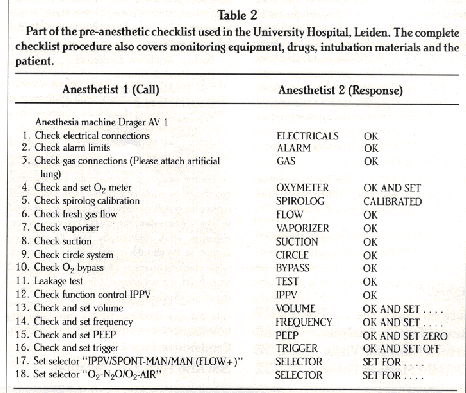Anesthesia and aviation have much in common, not least in the extensive use of modem technology to control and monitor the functioning of the respective patient or aircraft. There are many similarities between the workspace of an anesthetist in a modem operation theatre and that of the cockpit of an aircraft. Both systems are undeniably complex, having many human and technical elements interacting with each other. The ultimate aim of both anesthesia and aviation is to maintain a high standard of “customer” (patient or passenger) saw. Both tend to achieve this goal by utilizing the concept of teamwork (crew concept).
For many years, the routine and disciplined use of checklists has formed an integral part of standard operating procedures in aviation. Considerable time is spent on teaching and practicing these procedures during pilot training so that their use becomes automatic. A pilot, during routine and emergency procedures, backs up his memory with standard checklists. In contrast, an anesthetist in similar circumstances relies heavily on his memory alone.
In aviation, standard checklists am applied before all critical events such as engine start up, takeoff, descent, landing, etc. (Table 1). Items on the list are called out by one of the crew, while the other performs the specific check procedure. If one of them has doubts about an item on the checklist, reading stops until both agree that it is safe to proceed. This minimizes the possibility of misinterpreting or overlooking an item. Such a disciplined approach to the checking of equipment is essential when operating a complex piece of modem technology such as a Boeing 747, where lives of passengers and crew depend totally on the proper functioning of all its many systems.
Many of the items on the checklist will have been preset before carrying out the checklist procedure. Take off speed will have been calculated according to total aircraft weight, number of passengers and prevailing weather and set on the airspeed indicators by means of coloured pointers or ‘bugs’ set into the rim of the instruments. Engine settings will have been calculated and preset and the correct frequencies chosen for communication and navigation equipment. These actions are the equivalent of an anesthetist presetting tidal volume and ventilation frequency on a ventilator, adjusting alarm limits on monitoring equipment, etc. The checklist procedures serve as a double check that these preset items have been correctly carried out.
Although checklists are used in anesthesia (1,2,3), these have not been standardized, and a structured and disciplined approach to their routine use is often lacking. In the department of anesthesia in Leiden, we have been using checklists analogous to those used in aviation (Table 2). As in the cockpit, the checklist procedures are carried out by two people, usually an anesthetist and an anesthetic nurse(Note: the European anesthetic nurse has a different role than an American C.R.N.A.) One calls out the individual item on the checklist, the other is responsible for performing the check. Each has a joint responsibility for the proper carrying out of the procedure. If a fault is found, this must be corrected before proceeding with the remaining items on the checklist. The procedure covers not only the anesthesia and monitoring equipment but also the identification of drugs that have been drawn up prior to induction of anesthesia, checking of intubation materials and finally, and very importantly, the patient is checked. Though initially developed for a specific anesthesia machine, the list can be modified easily for other anesthetic apparatus.
Working through the complete checklist at the beginning of an operating session lasts about six to seven minutes. Shorter checklists are used between patients. A written record of the checklist procedures is kept on the patient’s anesthesia chart. These checklist procedures have been in use for more than two years and have had a very high acceptance rate both from anesthetists and nurses.
Checklists have also been developed for specific emergencies such as cardiac arrest and malignant hyperthermia. These are used, once the emergency situation has been brought under control, as a back up for the anesthetist to ensure that important items that might have been forgotten during the crisis are not overlooked. This is analogous to the emergency procedures in aviation, e-S. a fire in one of the engines.
Evidence that the use of checklists and, in general, better awareness of the relevance of critical incidents as well as the factors associated with them can improve saw was provided by a study by Kumar et al. (4) They carried out a prospective study into two one-year periods, one year before and one year after the introduction of checklist procedures. Eighty-six incidents were reported in the fast period, the majority of which (80%) were attributed to human error. The most common mishaps involved transmission of anaesthetic gases and vapours or errors in drug administration. There was a significant decrease in the number of incidents during the second one-year period, with an overall reduction in the total number of incidents reported from 86 to 43.
In conclusion, it is our contention that safety in anesthesia will be greatly enhanced if such a standard, structured, and disciplined approach (as exemplified by the use of checklists) is made an integral part of anesthesia training and practice
Dr. Chopra, is a Staff Anesthesiologist; Dr. Bovill is Research Professor; and Dr. Spierdijk is Professor at the Department of Anaesthesiology, University Hospital, Leiden, the Netherlands.
References
1. Cundy J., Baldock G.J. (I 982) Safety check procedure to eliminate faults in anaesthetic machines. Anaesthesia 1982; 37:161-169
2. ECRI. Avoiding anesthesia mishaps through pre-use checks. Health Devices 1982; 1 1:201-203
3. Kilian J., Safety check procedure and maintenance. European journal of Anaesthesiology 1987; 4:211-213
4. Killian V., Barcellos W A., Mehta M. P., Carter J. G. An analysis of critical incidents in a teaching department for quality assurance: A survey of mishaps during anaesthesia. Anaesthesia 1988; 43:879-883.



